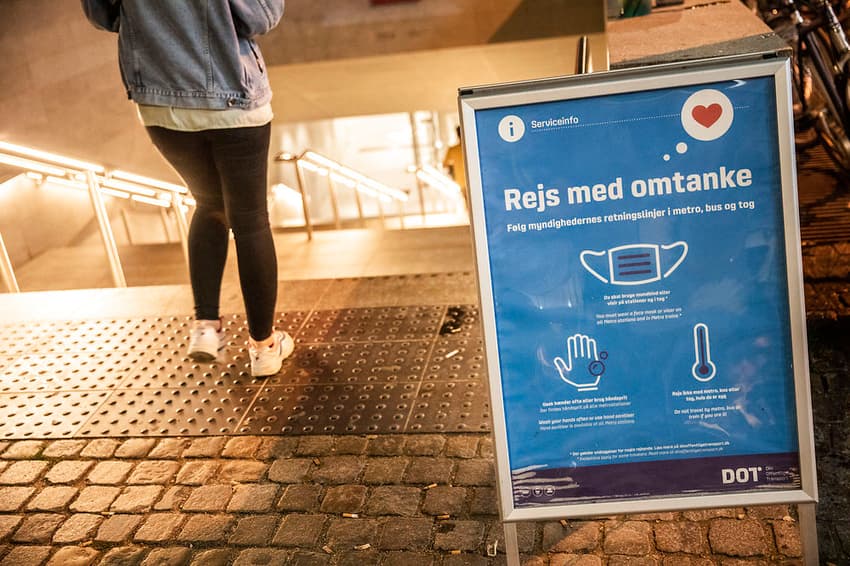Coronavirus in Denmark: infections 'stabilised', but face masks the new normal

The weekend saw 112 new cases of coronavirus registered in Denmark on Saturday, followed by 78 cases on Sunday.
Three fewer people were hospitalised on Sunday compared to Saturday, while the number of ICU admissions increased from one to two. One of the two intensive care patients is on a ventilator.
The latest figures come from the State Serum Institute, Denmark’s national infectious disease research agency.
The relatively large swing in cases registered Saturday and Sunday reflects a trend seen throughout last week. A total of 700 new cases of Covid-19 were recorded in Denmark in the week leading up to Sunday August 23rd.
READ ALSO:
-
Denmark registers lowest number of new Covid-19 cases in August
-
Danish police charge first person for refusing to wear a mask
A variation in numbers from one day to the next is not surprising, said Hans Jørn Kolmos, professor of microbiology at the University of Southern Denmark and consultant doctor at Odense University Hospital.
Infection spread in Denmark has “stabilised” during the last few weeks, Kolmos said.
“Just now we are keeping an eye on the number of new infections each week and right now I note that the numbers have stabilised,” he said.
“The figures are so small that they are subject to significant variation, so there’s a limit to how much you can set by them. But in general, we are seeing a positive trend – including based on the number of hospitalisations,” he added.
Saturday saw Denmark introduce obligatory wearing of face masks on all public transport in the country.
The face mask requirement will be necessary for the foreseeable future regardless of developments in infection numbers, Kolmos said.
“A lot of face masks will be need for a long time before you will be able to see in any serious way whether they have affected the (infection) numbers,” he said.
“When we see a stabilisation of infections, it might be tempting to ask oneself whether (face masks) are now needed. But we need to be firm here and say that it can change a lot from one day to the next, but that face masks are needed,” he said.
READ ALSO: Denmark's face mask requirement comes into force: these are the rules you need to know
Comments
See Also
Three fewer people were hospitalised on Sunday compared to Saturday, while the number of ICU admissions increased from one to two. One of the two intensive care patients is on a ventilator.
The latest figures come from the State Serum Institute, Denmark’s national infectious disease research agency.
The relatively large swing in cases registered Saturday and Sunday reflects a trend seen throughout last week. A total of 700 new cases of Covid-19 were recorded in Denmark in the week leading up to Sunday August 23rd.
READ ALSO:
- Denmark registers lowest number of new Covid-19 cases in August
- Danish police charge first person for refusing to wear a mask
A variation in numbers from one day to the next is not surprising, said Hans Jørn Kolmos, professor of microbiology at the University of Southern Denmark and consultant doctor at Odense University Hospital.
Infection spread in Denmark has “stabilised” during the last few weeks, Kolmos said.
“Just now we are keeping an eye on the number of new infections each week and right now I note that the numbers have stabilised,” he said.
“The figures are so small that they are subject to significant variation, so there’s a limit to how much you can set by them. But in general, we are seeing a positive trend – including based on the number of hospitalisations,” he added.
Saturday saw Denmark introduce obligatory wearing of face masks on all public transport in the country.
The face mask requirement will be necessary for the foreseeable future regardless of developments in infection numbers, Kolmos said.
“A lot of face masks will be need for a long time before you will be able to see in any serious way whether they have affected the (infection) numbers,” he said.
“When we see a stabilisation of infections, it might be tempting to ask oneself whether (face masks) are now needed. But we need to be firm here and say that it can change a lot from one day to the next, but that face masks are needed,” he said.
READ ALSO: Denmark's face mask requirement comes into force: these are the rules you need to know
Join the conversation in our comments section below. Share your own views and experience and if you have a question or suggestion for our journalists then email us at [email protected].
Please keep comments civil, constructive and on topic – and make sure to read our terms of use before getting involved.
Please log in here to leave a comment.